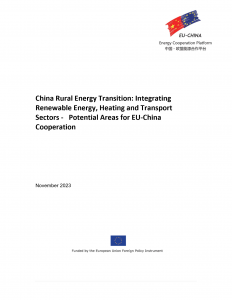
China leads the world in adoption of solar power and heat pumps, as well as EVs. In rural areas in particular, solar and EV adoption are booming, especially in eastern China, making this a good time to think about how to pair the technologies and so address the vexed issue of distribution grid inadequacy in rural China. Can bidirectional charging offer a solution that will allow excess solar power to be used in EVs?
ECECP has commissioned a new report to look at the prospects for bidirectional charging, and to propose ways for the EU and China to collaborate in order to achieve maximum energy efficiencies as the green transition accelerates.
Written by experts from the Oxford institute of Energy Studies and from the North China Electric Power University, the report includes a brief overview of how China has achieved the switch to solar, and its efforts to clean up rural heating and promote EV adoption. Its authors interview Chinese and European experts on the outlook for bidirectional charging, as well as on how best to cooperate in the fields of power market reform and the low-carbon energy transition.
The authors argue that the EU offers China a useful point of comparison, thanks to the fact that both regions have advanced and comprehensive strategies for addressing climate change, while each hosts large car markets and car manufacturing capacity, with a similar percentage of EVs in new sales. Europe also has an advanced electric power market and has achieved a high share of renewable energy in many regions.
In a modelling analysis of bidirectional charging in China, the report demonstrates that the technology, which is still in its infancy, offers modest electricity cost savings, increases PV household self-sufficiency, and allows drivers to complete their daily mileage without relying on additional charging facilities away from home. However, bidirectional charging does not fully eradicate the issue of excess solar output, and does not guarantee households full self-sufficiency.
The study also considers the options for ‘Vehicle-to-Grid’ integration of distributed rooftop PV at the village or household level. Smart charging pilots have identified benefits from using V2G to capture low-priced electricity and even greater benefits from pairing V2G with solar PV.
While full of promise, bidirectional charging technology faces major challenges, both in terms of upfront cost and in the economics of charging. In order for bidirectional charging to become widely adopted, rural household electricity prices will need to be adjusted, and the cost of bidirectional charging equipment will need to fall. The authors suggest sharing charging equipment, and encouraging grid companies to subsidise and coordinate bidirectional charging, as well as introducing community schemes rather than single household options.
When it comes to collaboration between the EU and China on rural energy, there are clear opportunities for companies in both regions. While Europe has vibrant, real-time wholesale power markets and experience of dynamic pricing, it is hampered by the high cost of equipment for bidirectional charging and by various regulatory barriers.
China, by contrast, is a manufacturing powerhouse, and is able to produce bidirectional equipment at relatively low cost. Its rural population is likely already motivated to consider bidirectional EV charging thanks to the widespread adoption of solar panels and associated excess solar output. However, the structure of residential electricity prices is not currently favourable to the new technology.
Looking ahead, low-cost Chinese bidirectional charging products could help resolve one of the biggest barriers to bidirectional charging in Europe. Experts in the EU and China argue that their markets and economies are highly complementary and their experiences relevant for exchange on the policy level. As one expert notes, if both regions attempt to find solutions to the low-carbon transition on their own, neither will be able to achieve their climate goals on schedule. Charting separate paths can only slow and weaken the clean energy transition.
Helen Farrell
Editor, ECECP
Download: PDF (3.26 MB)